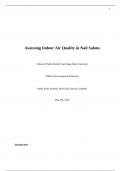1
Assessing Indoor Air Quality in Nail Salons
School of Public Health, San Diego State University
PH634: Environmental Protection
Maria Paula Noriega, Mia Gault, Soraya Campbell
May 9th, 2024
Introduction
, 2
Over the past years, nail salons have become a popular and common beauty industry
service in towns, malls, and neighborhoods. It is also a big employment sector, especially for
immigrants. The rapid growth of this industry has been fueled by the immigration of Vietnamese
and other Asian citizens who have built an economic niche offering different services such as
manicures, pedicures, and acrylic nails (Roelofs, 2012). This population can be vulnerable due to
potential language barriers when it comes to distinguishing warning labels and preventative
safety measures (Zhong, 2019). Due to the nature of nail products and nail care techniques, salon
air can be burdened with a mix of airborne contaminants. Chemicals in nail products, such as
volatile organic compounds (VOCs) and particulate matter (PM), pose potential health risks to
nail technicians and salon patrons due to prolonged exposure (Pollack et al., 2019).
Nail salons are a delicate topic of discussion for environmentalists, toxicologists, and
public health officials since many of the services offered in nail salons involve the use of
products containing hazardous chemicals and compounds. Many of the chemicals used have
been found to cause adverse health effects when individuals are exposed. The lengths of
exposure, acute or chronic, can deteriorate health, especially among nail technicians who are
constantly in contact with these chemicals. The products used such as nail polishes, nail
strengtheners, and nail removers contain many known hazardous chemicals, many of which are
distributed throughout salons. This can be seen as a serious issue for public health as the quality
of the air we breathe is essential for our health and well-being. Just as we are aware of
environmental pollution in outdoor air, we must also pay special attention to the air in indoor
spaces, as it can be up to 5 times more polluted (Pollack et al., 2019). Have you ever wondered
what the air is like in a beauty salon? This research aims to analyze and compare the air quality
experienced by nail technicians working in salon environments with the air quality of at-home
nail care. This research will help to fill the research gap into the comparison between air quality
among nail salons versus doing one’s nails at home.
Background Information
Chemical agents in beauty products can affect the respiratory tract, skin, and eyes. Nail
technicians have the highest exposure to such chemicals and are susceptible to many adverse
health effects, such as headaches and respiratory irritation that are consistent with indoor air
quality problems (Pavilonis et al, 2018). Products used in nail salons during certain nail
, 3
treatments contain many hazardous chemicals that are certain to cause specific harm to human
health. Some common chemicals found in nail products like polish and hardeners are acetone,
butyl acetate, ethyl acetate, formaldehyde, isopropyl acetate, methacrylic acid, methyl
methacrylate, isopropyl acetate, and toluene (Health Hazards in Nail Salons, n.d.). Formaldehyde
is classified in IARC in Group 1. This means that this chemical is a known carcinogen to humans
(Protano, 2021). Moreover, Isopropyl acetate is a known irritant. It causes drowsiness and
irritation of the eyes, nose, and throat with exposure.
Nail polish is made from many chemicals, but the main one in most of these products is
ethyl methacrylate. The U.S. Food and Drug Administration outlawed a similar chemical, methyl
methacrylate. This chemical was proven harmful to nail technicians and customers. MMA and
EMA can cause contact dermatitis, asthma, and allergies in the eyes and nose. Both can make the
eyes, nose, and other mucous membranes sting, become red, and swell (Spencer, 2014). Even if
customers are not being exposed every day to these chemicals, they are at risk too.
Finally, for this study it is important to know that particulate matter is divided into three
separate categories based on particulate size. PM around 1 micrometer can be sources of cars or
factory emissions and products of combustion and heating. PMs around 2.5 micrometers can be
sources of smoke, soot, dust, or aerosol particulates. PMs around 10 micrometers can be sources
of pollen, smoke, vehicle exhaust, or dust from construction sites and industrial sources. Then we
will do our nails at home with a nail kit and compare the air quality of nail salons with our home
environments.
Research Objectives
We will conduct an exposure assessment in different salons to determine if the smell,
vapors, and dust are just a nuisance or if they are detrimental to the workers' and customers'
health. The main data that we will be extracting from the Atmos Tube Pros are the particulate
matter, air quality and volatile organic compounds recordings. We will identify potential health
risks associated with exposure to air pollutants among nail technicians. Finally, this study aims to
provide evidence-based recommendations for improving indoor air quality and promoting the
well-being of nail technicians.
Methodology




